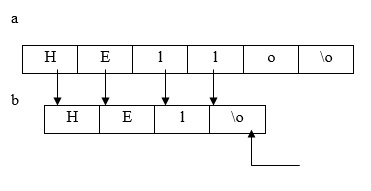C庫函數char *strcpy(char *dest, const char *src)複製指向的字符串,由src至dest。
字符數組稱為字符串。
聲明
以下是數組的聲明
char stringname [size];
例如 - char string[50];長度為 50 個字符的字符串
初始化
- 使用單字符常量 -
char string[10] = { ‘H’, ‘e’, ‘l’, ‘l’, ‘o’ ,‘\0’}- 使用字符串常量 -
char string[10] = "Hello":;
Accessing− 有一個控製字符串 "%s" 用於訪問字符串直到遇到‘\0’
strcpy() 函數
該函數用於將源字符串複製到目標字符串中。
目標字符串的長度大於或等於源字符串。
用法
語法如下 -
strcpy (Destination string, Source String);
示例
下麵的例子展示了 strcpy() 函數的用法。
char a[50]; char a[50];
strcpy ("Hello",a); strcpy ( a,"hello");
output:error output:a= "Hello"程序
下麵的程序顯示了 strcpy() 函數的用法。
#include <string.h>
main ( ){
char a[50], b[50];
printf ("enter a source string");
scanf("%s", a);
strcpy ( b,a);
printf ("copied string = %s",b);
getch ( );
}輸出
執行上述程序時,會產生以下結果 -
Enter a source string:Hello Copied string = Hello

讓我們看另一個關於 strcpy 的例子。
下麵給出的是一個演示 strcpy 庫函數的 C 程序 -
程序
#include<stdio.h>
#include<string.h>
void main(){
//Declaring source and destination strings//
char source[25],destination[50];
//Reading Input from user//
printf("Enter the string to be copied:");
gets(source);
printf("Enter the existing destination string:");
gets(destination);
//Using strcpy library function//
strcpy(destination,source);
//Printing destination string//
printf("Destination string is:");
puts(destination);
}輸出
執行上述程序時,會產生以下結果 -
Enter the string to be copied:C programming Enter the existing destination string:bhanu Destination string is:C programming
相關用法
- C語言 strcpy()用法及代碼示例
- C語言 strcspn()用法及代碼示例
- C語言 strcat()用法及代碼示例
- C語言 strchr()用法及代碼示例
- C語言 strcmpi()用法及代碼示例
- C語言 strcoll()用法及代碼示例
- C語言 strcmp()用法及代碼示例
- C語言 strtol()用法及代碼示例
- C語言 strrchr()用法及代碼示例
- C語言 strftime()用法及代碼示例
- C語言 strtok()用法及代碼示例
- C語言 strncat()用法及代碼示例
- C語言 strupr()用法及代碼示例
- C語言 strlen()用法及代碼示例
- C語言 strtod()用法及代碼示例
- C語言 strspn()用法及代碼示例
- C語言 strstr()用法及代碼示例
- C語言 strxfrm()用法及代碼示例
- C語言 strrev()用法及代碼示例
- C語言 strtok()、strtok_r()用法及代碼示例
注:本文由純淨天空篩選整理自Bhanu Priya大神的英文原創作品 What is strcpy() Function in C language?。非經特殊聲明,原始代碼版權歸原作者所有,本譯文未經允許或授權,請勿轉載或複製。
